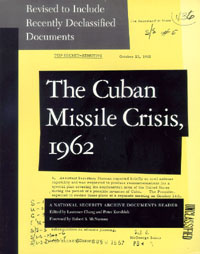 |
|
|
Ordering
information for this book is available at the
W.W. Norton & Co. website. Or by phone:
800-233-4830 (U.S.)
717-346-2029 (Outside U.S.)
|
|
|
|
|
|
|
|
|
|
|
|
|
|
|
|
|
|
|
|
NEWS RELEASE
10 October 2002
|
For more information, contact:
Thomas S. Blanton or
Peter Kornbluh 202 / 994-7000
|
-
VETERANS OF CUBAN MISSILE
CRISIS ARRIVE IN HAVANA;
-
CUBAN VICE PRESIDENT GREETS
McNAMARA, SORENSEN, KENNEDYS;
-
CONFERENCE TO FEATURE NEW
CUBAN, US, SOVIET SECRETS
Havana, Cuba, 10 October 2002 - Senior
surviving veterans of the Cuban missile crisis arrived today
in Havana for a historic 40th anniversary conference co-organized
by the National Security Archive at George Washington University.
At an airport arrival ceremony, Cuban vice president Jose
Ramon Fernandez greeted former US secretary of defense Robert
McNamara, JFK speechwriter and counsel Theodore Sorensen,
JFK aide and Pulitzer-Prize-winning historian Arthur Schlesinger
Jr., Gen. William Y. Smith (USAF), JFK aide Richard
Goodwin, CIA analyst Dino Brugioni, and other US
veterans and scholars. Also attending the conference as honored
observers are several members of the Kennedy family spanning
three generations. Earlier this week, a distinguished delegation
of Russian veterans arrived in Havana from Moscow, including
former deputy foreign minister Georgy Kornienko, missile
deployment planner Gen. Anatoly Gribkov, former defense
minister Dmitry Yazov, and KGB officer Nikolai Leonov.
This historic conference - titled "La Crisis de Octubre:
una vision politica 40 anos despues" - begins at 10 a.m.
on Friday, October 11, and will feature four panels: (1) from
the Bay of Pigs to the missiles, (2) the missiles and the
October crisis, (3) the November crisis and aftermath, (4)
lessons from the crisis. At the center of discussions will
be thousands of pages of newly declassified documents
- from the Cuban government itself, from the CIA, the Pentagon
and the White House, from the Soviet Foreign Ministry and
the Politburo, and from Poland, Hungary, the Czech Republic,
Brazil, Canada, Great Britain, and Mexico - providing for
the first time the Cuban and multi-national perspectives on
a crisis previously seen only in superpower terms. Archive
director Thomas Blanton said, "The conference room will
echo with words that resonate today, such as 'intelligence
failure,' 'pre-emptive strike,' and 'weapons of mass
destruction.'"
On Sunday, October 13, conferees will visit the last surviving
structure from the Soviet deployment in 1962, a nuclear warhead
bunker at the San Cristobal missile site west of Havana.
On Monday, October 14, participants will depart Havana. On
this day in 1962, a high-altitude U-2 spy plane took the first
photographs of the Soviet medium-range ballistic missiles
in Cuba - at San Cristobal. The conference will meet at the
Palacio de Convenciones in Havana, Cuba. Most participants
will be housed at the Hotel Palco next door. Phone: 011-53-7-337235.
Fax: 011-53-7-337236. The conference room itself is closed
to the press, except for the opening ceremony at 10 a.m. on
October 11; but the organizers will hold daily press briefings
each afternoon summarizing the discussion and releasing key
documents addressed that day. The visit to the missile site
is open to the media.
The National Security Archive co-organized with Cuban institutions
the highly successful 40th anniversary Bay of Pigs conference
last year in Havana; this year, the Archive is also working
in partnership with Brown University's Watson Institute. Peter
Kornbluh directs the Archive's Cuba project.
|

